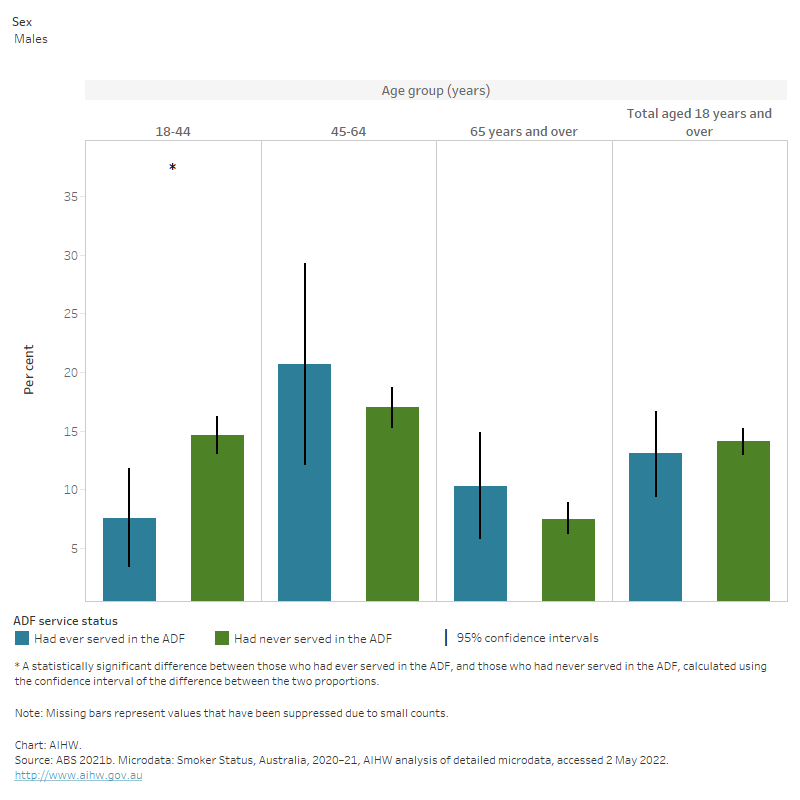Demographic profile of veterans who smoke
Previous ABS analysis of the Smoker Status, Australia 2020–21 data set indicated that in 2020–21, around 11% of Australians aged 18 years and over were daily smokers, irrespective of whether they had ever served in the ADF (ABS 2021a).
To account for small cohort sizes and allow for more detailed analysis of smoking among Australia’s veteran community, this Smoking among Australia’s veterans 2020–21 report has combined current daily smokers with current non-daily smokers to form the ‘current smoker’ subpopulation discussed throughout the remainder of this report.
Data considerations
Data from Smoker Status, Australia 2020–21 presented on this page have been tested for significance at the 5% level using confidence intervals of the differences between two proportions, and comprehensive tables are available in Smoking among Australia’s veterans 2020–21: supplementary data tables – Table S1. For more information on the methodology used, see Technical notes.
While comparisons can be inferred from the information provided on this page, some differences between persons who have and have not served in the ADF are likely to be confounded by the older age structure of the ADF population, and comparisons should be used as a guide only. The results presented below have not been adjusted for age as the data could not meet requirements to do so, and readers should take this into consideration when interpreting the results. For more information, see Differences in age structures among ADF service status populations.
The unique nature of ADF service can enhance a person’s health and wellbeing; a phenomenon known as the 'healthy soldier effect'. Military personnel are generally physically and mentally fit, receive regular medical assessments, and have access to comprehensive medical and dental treatment as a condition of service. However, ADF service increases the likelihood of exposure to trauma (either directly or indirectly) and affects support networks, for example, separation from family during deployment (Daraganova et al. 2018; Lawrence-Wood et al. 2019). For more information, see Who is a Veteran?.
AIHW analysis of the ABS Smoker Status, Australia 2020–21 data set indicated that in 2020-21 overall, an estimated 78,200 people who had ever served in the ADF were current smokers. Around 71,200 were male, and 7,000 were female (Figure 1). Of these:
- males were more likely to be current smokers than females (13% compared with 6.7%). This pattern was observed across most age groups, irrespective of ADF service status. The exception to this was those aged 65 years and over who had never served in the ADF, where males and females were equally likely to smoke (7.5% compared with 6.3%, respectively).
- among males, those aged 45–64 had the highest rate of current smoking of any age group (21%).
- fewer than 1 in 10 (7.6%) males aged 18–44 were current smokers. This was 1.9 times lower than males of the same age group who had never served in the ADF (15%).
Rates of current smoking were the same between persons [1] who had ever served in the ADF, and persons [1] who had never served in the ADF (12% for both).
[1] Males and females combined
Figure 1: Current smoker status of males, by age and ADF service status, 2020–21
The bar charts show that rates of current smoking were similar between ADF service statuses, regardless of sex. Males aged 18 to 44 were less likely to smoke if they had ever served in the ADF.

ABS (Australian Bureau of Statistics) (2021a) Pandemic insights into Australian smokers, 2020–21, ABS, Australian Government, accessed 20 May 2022.
ABS (2021b) Microdata: Smoker Status, Australia, 2020–21, AIHW analysis of detailed microdata, accessed 2 May 2022.
Daraganova G, Smart D and Romaniuk H (2018) Transition and Wellbeing Research Programme Family Wellbeing Study. Part 1: Families of current and ex-serving ADF members: health and wellbeing, Defence and Department of Veterans’ Affairs, Australian Government, accessed 2 August 2022.
Lawrence-Wood E, McFarlane A, Lawrence A, Sadler N, Hodson S, Benassi H, Bryant R, Korgaonkar M, Rosenfeld J, Sim M, Kelsall H, Abraham M, Baur J, Howell S, Hansen C, Iannos M, Searle A, and Van Hooff M (2019) Impact of combat report, Defence and Department of Veterans’ Affairs, Australian Government, accessed 2 August 2022.


